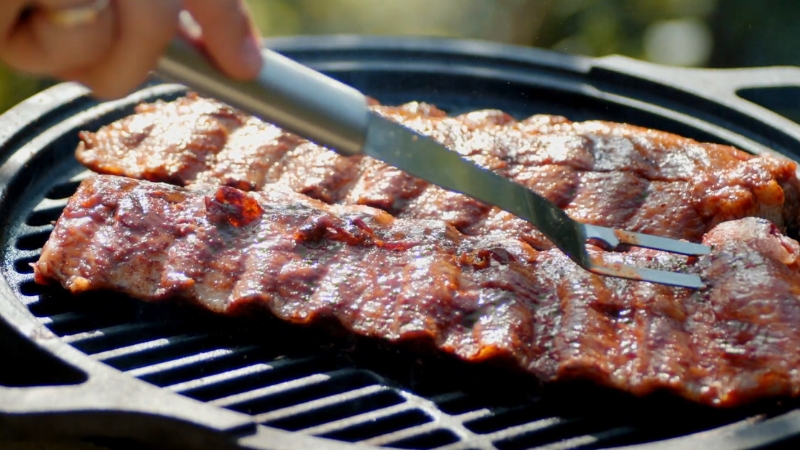You can make memorable beef ribs with nothing more than salt, pepper, steady heat, and the right smoke. What turns a solid cook into a brag-worthy plate is how the wood layers flavor over time.
When you choose the right mix, the bark develops a deeper color, the aroma settles into the fat cap, and the whole rack comes off the pit with that buttery, smoky profile people talk about later.
In this guide, we’ll look at why beef ribs love bolder smoke, how to pair woods so you don’t wind up with a bitter crust, and exactly how much wood to feed your pit for a steady burn.
Let’s begin.
Key Points
- Clean fire and seasoned hardwood (15-22% moisture) matter more than wood type for flavor and safety
- Post oak is the steady baseline wood, with hickory, pecan, mesquite, and fruit woods used for layered flavor
- Use specific ratios to balance intensity and sweetness (e.g., oak + cherry, mesquite + pecan)
- Match wood choice and chunk size to cooker type for consistent burn and clean blue smoke
Clean Fire First, Wood Species Second
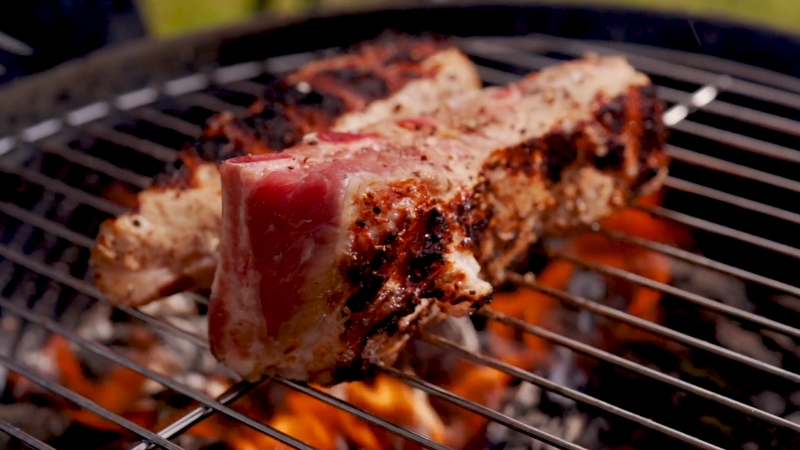
Pit science writers repeatedly emphasize that a clean fire matters more than any single wood type. Moisture, airflow, and combustion temperature drive flavor more than the species printed on the bag.
Aim for fully seasoned hardwood in the 15 to 22 percent moisture range. That sweet spot produces thin, almost invisible blue smoke and avoids the billowy white smoke that can lay down bitter creosote.
Safety Comes Before Flavor
Beef ribs cook best between 225 and 300°F. Always verify with a reliable pit thermometer.
Food safety authorities recommend at least 145°F with a three-minute rest for whole cuts of beef, though most pit cooks go much higher to break down collagen.
Probe for tenderness rather than chasing a number.
The Core Woods for Beef
Here’s a quick overview before we jump into the combinations:
- Oak (especially post oak) – Clean, medium-bold smoke. The Central Texas standard.
- Hickory – Traditional and robust.
- Pecan – Nutty, slightly sweet, softening the edges without going fruity.
- Mesquite – Intense, earthy smoke. Powerful but can turn bitter fast on long cooks.
- Cherry – Gentle sweetness and deep mahogany color on the bark.
How Much Wood to Feed the Fire
For chunk-fired smokers and kettles, a practical starting point is 3 to 4 ounces of wood per hour for beef ribs.
Spread chunks evenly through a charcoal snake for a steady feed over a 5 to 7 hour cook. Offset stickburners are a different game. Add small splits as needed to hold clear blue smoke.
Many pitmasters use cured oak splits as a base and add fruit wood only as an accent.
9 Best Wood Combinations for Beef Ribs
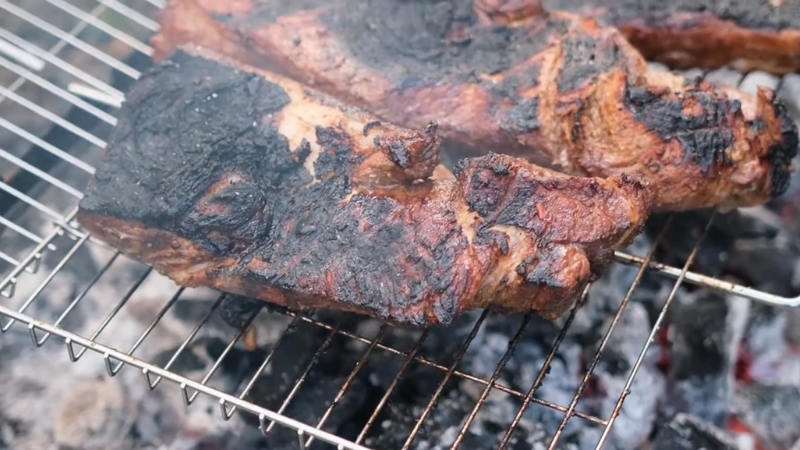
Below are proven blends for plate ribs, English-cut chuck ribs, and other meaty beef rib cuts.
1. Post Oak 100 Percent
- Ratio: 100 percent post oak
- Why it works: The Texas benchmark. Balanced, steady, and clean. Let the rib’s beefy flavor lead while building a solid bark.
- When to use: First time dialing in a new smoker or when you want a clear baseline for rubs, spritzes, and wrap timing.
2. Post Oak 70 Percent + Cherry 30 Percent
- Ratio: 70:30 oak to cherry
- Why it works: Oak’s backbone plus cherry’s gentle sweetness and burgundy color. Cherry adds visual appeal without pushing fruit flavor too far.
- When to use: Guests who like a hint of sweetness and a show-stopping bark color.
3. Oak 60 Percent + Hickory 40 Percent
- Ratio: 60:40 oak to hickory
- Why it works: A traditional barbecue profile that reads hearty without turning aggressive. Hickory drives that classic BBQ nose, oak keeps combustion stable.
- When to use: Cold or windy days when the pit benefits from oak’s steady burn but you still want bold flavor.
4. Hickory 60 Percent + Cherry 40 Percent
- Ratio: 60:40 hickory to cherry
- Why it works: Cherry softens hickory’s punch and adds color. Good for a competition-style rib look.
- When to use: Heavier-rub cooks and ribs finished with a tallow glaze, where sweetness needs balance.
5. Pecan 70 Percent + Oak 30 Percent
- Ratio: 70:30 pecan to oak
- Why it works: Pecan’s nutty sweetness is lovely on beef but can run mild on its own. Oak bolsters heat and keeps the profile steady.
- When to use: Afternoon backyard cooks where you want a graceful, approachable smoke that still reads as beefy.
6. Mesquite 30 Percent + Oak 70 Percent
- Ratio: 30:70 mesquite to oak
- Why it works: Earthy mesquite signature without risking bitterness on a long cook. Oak buffers combustion and prevents heavy smoke accumulation.
- When to use: Shorter beef rib cooks in hot offsets or when you crave that South Texas hint without going all in.
7. Mesquite 20 Percent + Pecan 80 Percent
- Ratio: 20:80 mesquite to pecan
- Why it works: Pecan’s round sweetness tames mesquite’s edges. Great way to introduce mesquite to guests who normally avoid it.
- When to use: Smaller racks or when finishing ribs uncovered for an extra hour to build bark.
8. Oak 50 Percent + Apple 25 Percent + Cherry 25 Percent
- Ratio: 50:25:25 oak to apple to cherry
- Why it works: Balanced perfume and color. Apple stays in the background on beef but brings a friendly fruit note that plays well with pepper-heavy rubs.
- When to use: Family cooks where different palates need a consensus profile.
9. White Oak 70 Percent + Hickory 20 Percent + Cherry 10 Percent
- Ratio: 70:20:10
- Why it works: White oak burns long and clean. A touch of hickory adds backbone, cherry adds a little color. Very forgiving on kettles using the charcoal snake.
- When to use: Overnight cooks or any time you want fewer lid lifts and a reliable burn curve.
How to Match Wood to Cooker Type
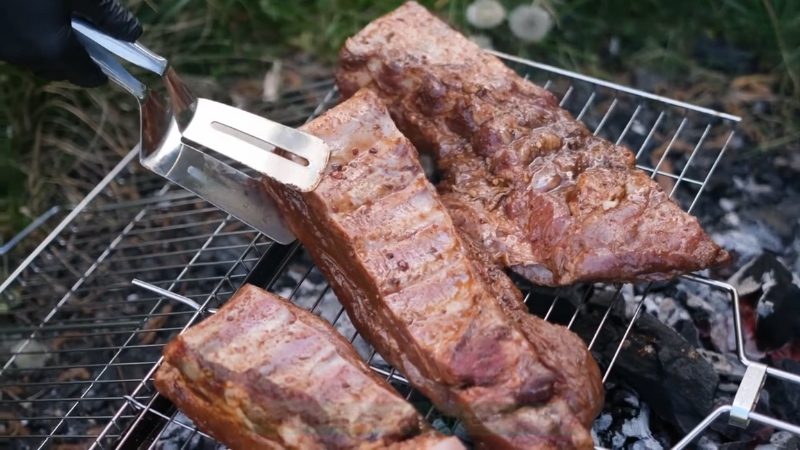
Different smokers handle fuel in their own way, so it helps to match your wood choice to the cooker. A few tweaks here save time and flavor later.
Offset Stickburners
Run small, hot fires. Add modest splits frequently to stay in the clean-smoke window. Oak is your stability partner, fruit woods are accents.
Kettle Grills
Use a charcoal snake with wood chunks spaced every 4 to 6 inches along the path. One chimney of unlit briquettes plus 8 to 10 lit briquettes to start will hold 250 to 300°F for hours.
Drop 1 to 2 chunks at the start and let the snake feed the rest.
Pellet Grills
Pellets lean toward milder smoke. Choose blends labeled competition or single species like oak or hickory for beef ribs.
For a stronger profile, go with hickory-heavy or mesquite blends and run the pit in its lower temperature band during the first two hours to maximize smoke generation.
Kamado and Insulated Cookers
Use fewer chunks. These pits are efficient and can over-smoke quickly if loaded like a kettle.
Start with two fist-size chunks of your chosen blend and add only if the fire stays clean and you want more aroma in the first half of the cook.
Wood Quality and Moisture
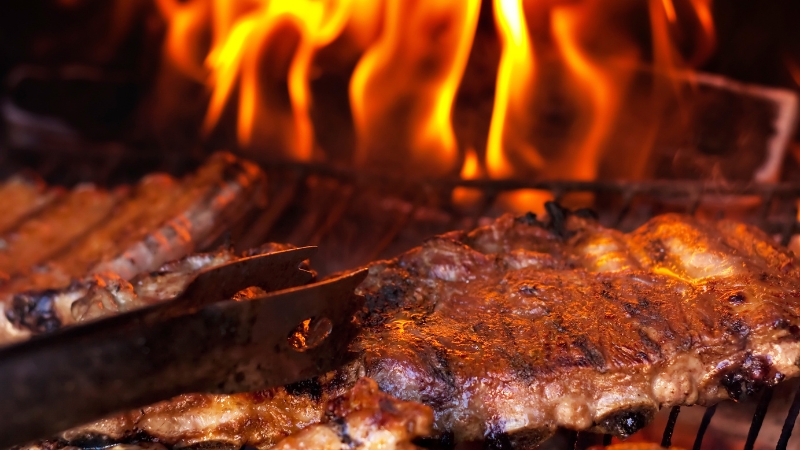
- Seasoned vs kiln-dried: Air-dried, seasoned wood with at least six months to cure is ideal. Kiln-dried can burn too hot and fast, risking harsh smoke. If you buy kiln-dried, look for moisture in the teens rather than single digits.
- Target moisture: 15 to 22 percent hits the sweet spot for clean smoke and easy ignition.
- Size: Use chunks roughly the size of a closed fist for kettles and kamados. In offsets, favor smaller splits to encourage quick ignition and less smoldering.
Flavor Science in Simple Terms
- Blue smoke beats white: At around 650 to 750°F on the wood surface, you get the most desirable aromatic compounds without the acrid byproducts that arrive at higher temps. If you see thick white smoke, increase airflow or burn smaller pieces.
- Most flavor lives at the surface: Smoke molecules adhere to the exterior. That’s why spritzing and bark management matter more than any late-cook wood change.
- Region and availability shape preferences: Texas A&M notes that Texans gravitate to oak, hickory, pecan, and mesquite because they’re abundant. Your best wood is the quality hardwood you can get consistently.
Step-by-Step Game Plan for Beef Ribs
View this post on Instagram
Before you light the fire, it helps to have a simple roadmap. Here’s a quick, practical sequence to keep your beef ribs on track from start to finish.
Trim and Season
Square up ragged fat and thin edges so the rack cooks evenly. Keep a thin, fat cap.
Season with kosher salt and medium-grind black pepper in a 1.5 to 1 ratio for Central Texas style, or add small amounts of garlic and onion powder if you like.
Fire Setup
Choose your combo from the list above. For most pits, start with 3 to 4 ounces of smoke wood per hour. Plan for 5 to 7 hours, depending on thickness.
Keep the pit between 225 and 300°F and favor the cleanest blue smoke you can maintain.
Cook and Manage Bark
Avoid heavy white smoke in the first two hours when the surface is still wet and most receptive.
If the bark is on track by 165 to 175°F internal, you can wrap it in unwaxed butcher paper to protect color and push through the stall, or ride it unwrapped if humidity is high and your smoke stays clean.
Finish by Feel
Probe for tenderness in the thickest intercostal. Most beef ribs finish between 200 and 205°F internally, but go by feel.
Rest loosely tented until the bark relaxes and the juices settle.
Quick-Look Pairing Table
| Wood blend | Ratio by weight | Flavor profile on beef ribs | Best use case |
| Post oak | 100 percent | Clean, medium-bold, classic Central Texas | Baseline cooks, technique testing |
| Oak + Cherry | 70 + 30 | Balanced, light sweetness, rich bark color | Company ribs, photogenic bark |
| Oak + Hickory | 60 + 40 | Hearty, traditional BBQ nose, stable burn | Windy days, stronger rubs |
| Hickory + Cherry | 60 + 40 | Robust with softened edges, mahogany color | Competition-style presentation |
| Pecan + Oak | 70 + 30 | Nutty-sweet, approachable, still beef-forward | Family cooks, mixed palates |
| Mesquite + Oak | 30 + 70 | Earthy accent without bitterness | Shorter cooks, South Texas vibe |
| Mesquite + Pecan | 20 + 80 | Tamed mesquite with rounded sweetness | Guests wary of mesquite |
| Oak + Apple + Cherry | 50 + 25 + 25 | Balanced, gentle fruit aroma, great color | Pepper-heavy rubs, kettles with snake method |
| White Oak + Hickory + Cherry | 70 + 20 + 10 | Long burn, classic aroma, slight color bump | Overnight cooks, low-touch sessions |
Fixing the Flavor
- Ribs taste bitter: Probably smoldering, oxygen-starved combustion. Open the exhaust, use smaller splits, and stick to seasoned wood in the 15 to 22 percent moisture band.
- Ribs taste flat or weak: Too little wood or too mild a species for your pit size. Increase total wood weight per hour by 25 percent and consider adding a 20 to 40 percent hickory component.
- Bark too dark but meat still tight: Wrap in butcher paper once color is set, then finish to feel. The smoke ring won’t increase much after the first couple of hours, so focus on tenderness.
Final Tips That Move the Needle
@cooking_with_fireSmoked beef ribs♬ original sound – Miguel
- Favor post oak when in doubt. It’s the Central Texas baseline for good reason.
- Think in ratios. A small percentage of mesquite or hickory goes a long way on long cooks.
- Keep logs and chunks off damp ground, stacked to air out, and rotated.
- Use a charcoal snake on kettles for set-and-forget rib sessions. Space your chunks along the path so smoke arrives gradually rather than in one big burst.
- Measure with a food thermometer and a pit thermometer. It improves both safety and repeatability.
